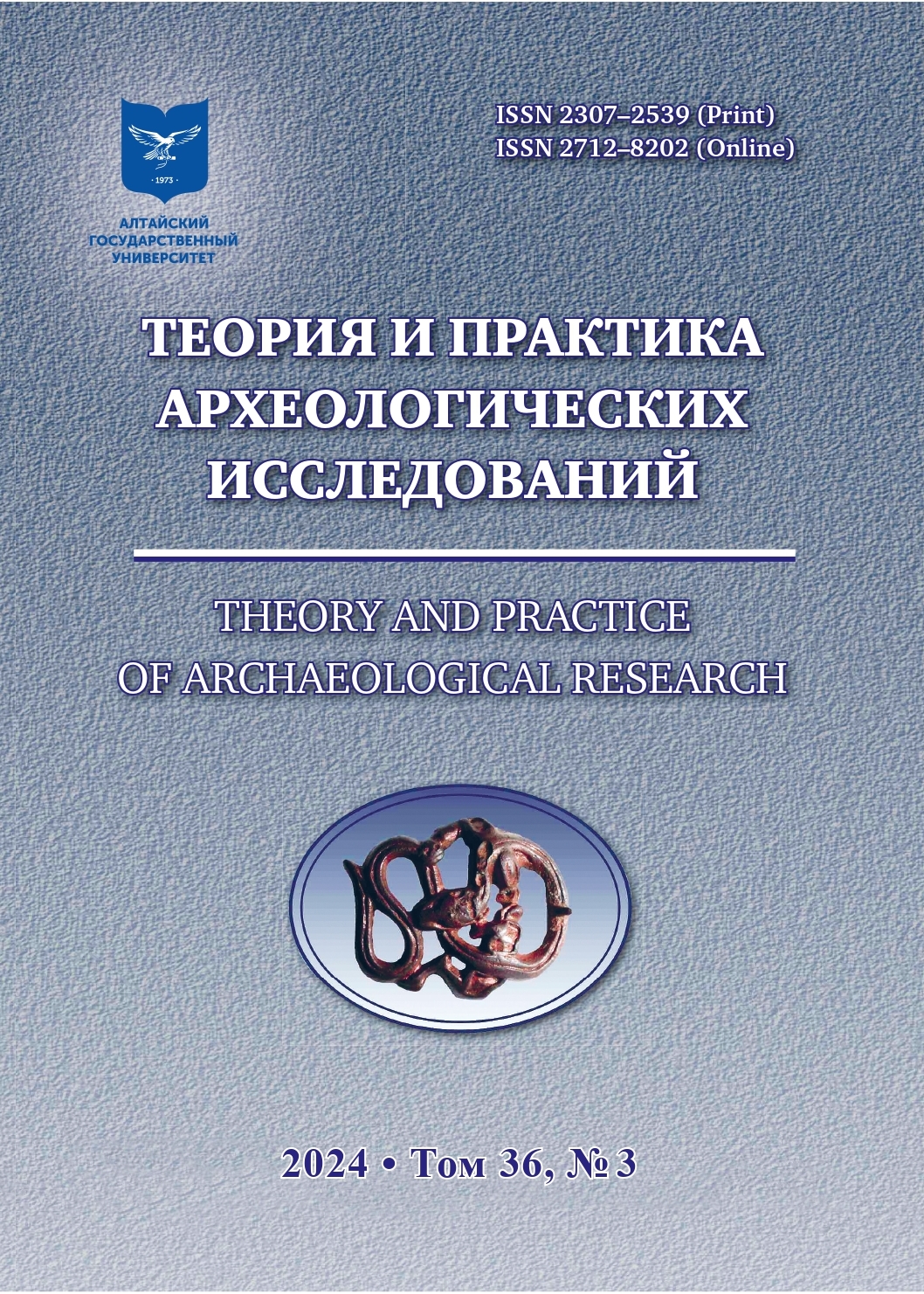CRITERIA FOR DISTINGUISHING DIFFERENT TYPES OF BLADED WEAPONS (DAGGERS, SWORDS, KNIVES) ACCORDING TO THE IMAGES ON “DEER” STONES
Abstract
Within the framework of the article, the criteria for distinguishing the bladed weapons presented on the «deer» stones are considered. Daggers are most often fixed among this block of realities, knockouts of swords and combat knives are less common. Despite the obvious relevance of this issue, it was previously only casually touched upon by the authors dealing with this issue. At the same time, the reconstruction of the military kit presented on each of the statues depends on the correctness of the identification of the type of weapon. To identify significant features, a consistent analysis of the material is carried out. Initially, definitions and the most characteristic general features of the morphology of the weapons in question are given. Next, the material sources are analyzed, which allow us to trace the nuances of the design of synchronous «deer» stones of weapons, to clarify some specific features of its design. Of these, those that can be reflected in the images are highlighted. In conclusion, the proposed methods are considered on specific images.
Downloads
Metrics
References
Volkov V.V. Deer Stones of Mongolia. Moscow : Nauchnyj mir, 2002. 248 р. (In Russ.)
Gantulga J., Yeruul-Erdene C., Magai J. Some Results of the Study of Deer Stones in the Valley of the Hoyt Tamir River. Nauchnoe obozrenie Sayano-Altaya = Scientific review of the Sayano-Altai. 2020;1(25):45–59. (In Russ.)
Gorbunov V.V. Military Affairs of the Altai Population in the 3rd–14th centuries BC. Vol. II. Offensive Weapons (weapons). Barnaul : Izd-vo Alt. un-ta, 2006. 232 р. (In Russ.)
Gorbunov V.V. The Short Sword of the Spartan Hoplites (according to written, pictorial and material sources). In: War and Weapons. New Research and Materials. St. Petersburg : VIMAIViVS, 2021. Рр. 315–331. (In Russ.)
Gorelik M.V. Weapons of the Ancient East (the 4th millennium — the 4th century B.C.). St. Petersburg : Atlant, 2003. 336 р. (In Russ.)
Kiryushin Yu.F., Tishkin A.A. The Scythian Epoch of the Altai Mountains. Part I. Culture of the Population in the Early Scythian Period. Barnaul : Izd-vo Alt. un-ta, 1997. 232 p. (In Russ.)
Turbat Ts. (ed.). The Culture of Deer Stones in Mongolia and Neighboring Regions. Scientific Catalog. Vol. I. The Second Edited. Ulanbator, 2021. 496 р. (In Mong.)
Likhacheva O.S. Morphological Analysis of Bronze Age Daggers of the Ob-Irtysh Interfluve. In: The Eurasian Cultural Space. Archaeology, Ethnology, Anthropology. Irkutsk : Ottisk, 2010. Рр. 240–242. (In Russ.)
Likhacheva O.S. Bladed Weapons of the Early Iron Age from the Forest-Steppe Altai: the Problem of Morphological Differentiation. In: War and Weapons. New Research and Materials: Proceedings of the Tenth International Scientific and Practical Conference. St. Petersburg: VIMAIViVS, 2012. Рр. 165–181. (In Russ.)
Likhacheva O.S. Armament and Military Affairs of the Population of the Forest–Steppe Altai in the Early Iron Age (the 8th –1st Centuries BC). Barnaul : IP Kolmogorov I.A., 2020. 304 p. (In Russ.)
Maczumoto K. Karasuk Daggers — Their Origin and Distribution. Nauchnoe obozrenie Sayano-Altaya = Sayano-Altai Scientific Review. 2015;1(9):19–34. (In Russ.)
Melyukova A.I. The Armament of the Scythians. Moscow : Nauka, 1964. 91р. (Code of archaeological sources. Issue Д1-4). (In Russ.)
Olkhovsky B.C. A Monumental Sculpture of the Population of the Western Part of the Eurasian Steppes of the Early Iron Age. Moscow : Nauka, 2005. 299 р. (In Russ.)
Polyakov A.V. Analogies to Bronzes from The Minusinsk Basins on the Deer Stones of Mongolia. In: The Creator of Culture. Material Culture and the Spiritual Space of Man
in The Light of Archaeology, History And Ethnography. Saint-Petersburg : Institut istorii material’noj kul’tury, 2021. Рр. 634–642. (In Russ.)
Tishkin A.A. Identification, Documentation and Study of “Deer” Stones in the Valley of the Buyanta River (Mongolian Altai). Teoriya i praktika arheologicheskih issledovanij = Theory and Practice of Archaeological Research. 2013;7(1):73–90. (In Russ.)
Tishkin A.A. New Finds of “Deer” Stones in Mongolia with the Image of a Sword and a Shell. Vestnik TGU. Istoriya = Bulletin of TSU. History. 2016;4(42):117–123. (In Russ.)
Khudyakov Yu.S., Erdene-Ochir N. Military Affairs of the Ancient Nomads of Mongolia (the 2nd millennium — 3rd century BC). St. Petersburg : Filologicheskij fakul’tet SPbGU; Nestor-Istoriya, 2011. 172 р. (In Russ.)
Chlenova N.L. Karasuk Daggers. Moscow : Nauka, 1976. 204 р. (In Russ.)
Chlenova N.L. Deer Stones as a Historical Source (using the example of deer stones of the North Caucasus). Novosibirsk : Nauka, 1984. 99 р. (In Russ.)
Erdenechuluun P., Erdenebaatar D. Heavenly Sword: The Culture of Bronze Products from the Bronze Age to the Xiongnu Empire. Ulan-Bator, 2011. 496 р. (In Mong.)
Copyright (c) 2024 О.С. Лихачева

This work is licensed under a Creative Commons Attribution 4.0 International License.
Theory and Practice of Archaeological Research is a golden publisher, as we allow self-archiving, but most importantly we are fully transparent about your rights.
Authors may present and discuss their findings ahead of publication: at biological or scientific conferences, on preprint servers, in public databases, and in blogs, wikis, tweets, and other informal communication channels.
Theory and Practice of Archaeological Research allows authors to deposit manuscripts (currently under review or those for intended submission to ABS) in non-commercial, pre-print servers such as ArXiv.
Authors who publish with this journal agree to the following terms:
- Authors retain copyright and grant the journal right of first publication with the work simultaneously licensed under a Creative Commons Attribution License (CC BY 4.0) that allows others to share the work with an acknowledgement of the work's authorship and initial publication in this journal.
- Authors are able to enter into separate, additional contractual arrangements for the non-exclusive distribution of the journal's published version of the work (e.g., post it to an institutional repository or publish it in a book), with an acknowledgement of its initial publication in this journal.
- Authors are permitted and encouraged to post their work online (e.g., in institutional repositories or on their website) prior to and during the submission process, as it can lead to productive exchanges, as well as earlier and greater citation of published work (See The Effect of Open Access).








2.jpg)




